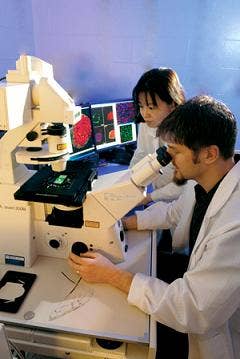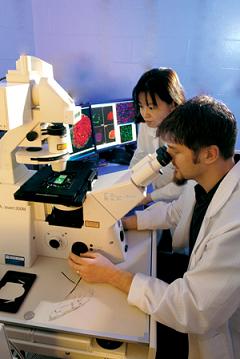Stem Cells Into Intestinal Tissue, More Biological Alchemy for Your Body

Share
It's time to check off another item on the list of body parts that we can recreate in a lab. Researchers at the Cincinnati Children's Hospital Medical Center have succeeded in transforming stem cells into parts of an intestine. Their work, recently published in Nature, relied on human embryonic stem cells (hESC) as well as induced pluripotent stem cells (iPS) derived from human skin. Over the course of a month in their lab, the Cincinnati team was able to transform the stem cells into flat sheets of tissue, encourage that tissue to roll up into a tube, and then populate the tube with all the kinds of cells and structures seen in the normal intestines of a fetus. You can see the slide-show presentation about this experiment in the video below. While still in its early stages, this research is the first step towards creating intestines for transplant. It may also lend valuable insight into how intestines develop, absorb nutrients, and react to prescription medications.
Creation of the intestinal tissue was lead by James W. Wells who has a history of researching embryonic development, embryonic stem cells and cancer in the intestines. The following slideshow is only a brief overview of the stem cell to intestine project, but it does have some interesting photos.
During gestation, human bodies are slowly formed from stem cells. Your eyes, your teeth, muscles, organs, you name it. Now, scientists have been able to recreate a growing number of adult body parts using stem cells as well. Simple organs like tracheas have been constructed from stem cells, and even successfully transplanted into human recipients. We've also seen success with bone marrow, muscle tissue (including the cardiovascular tissue), corneas, livers, lungs, blood, and many other parts of the body. In that light, the work at Cincinnati Children's Hospital could be seen as just another link in the chain. Like some bizarre reversed version of the board game Operation, stem cell scientists are slowly becoming able to place newly created tissues into the body.
Be Part of the Future
Sign up to receive top stories about groundbreaking technologies and visionary thinkers from SingularityHub.


What makes the Cincinnati work with intestinal tissue interesting is the complexity of the organ created. A variety of different cell types were grown from the hESC and iPS, including endodermal cells, enterocytes, goblet cells, Paneth cells, and enteroendocrine cells. Wells and his team used special biological markers to track the growth of these different kinds of cells, and you can see different groups clearly delineated by their bright colors in the photos in the slideshow above. Those photos are wonderful evidence that the Cincinnati team not only could get the different cell types to grow in the lab, but that they could be located fairly accurately in the segments of artificial intestine they created.
Also of note, Wells and his team grew the intestine using chemical signaling. One set of growth factors would stimulate the stem cells to form sheets of tissue. Other growth factors encouraged those sheets to curl up into a 3D shape. In this way they were mimicking the normal development process that stem cells would see in utero.
While the team did not form a complete intestinal tract, they did form smaller segments, referred to as organoids, that have all the finger-like villi and crypt structures of a normal intestine. Inside these structures were intestinal stem cells normally associated with the organ. In other words, while the team didn't make an intestine that could replace yours, they did show that it could be done with a process based on their techniques. In fact, the researchers have been able to develop muscle tissue along the organoids (to help move food through) and are working on associated nerve cells (to tell the muscle to contract). According the Cincinnati Children's Hospital, some of the authors of the Nature report are working to start testing these artificial organ systems in the bodies of animals fairly soon.
The creation of intestines from stem cells strikes me as very good science - it demonstrated the plausibility of a project (growing intestines in a lab), it gave great insights into the mechanics of the processes behind that project (by tracking cell types), and it opened up new avenues for further research (using the organoids to understand how intestines develop and absorb nutrients/medications). Like all good science, there's going to a tendency to over-hype this work. No, we won't be implanting new intestines in patients soon - it's going to take years of further research. Wells and his team have simply taken us another step towards that goal. That's great news, and as I said repeatedly, these researchers are not alone in their efforts to grow new parts of the body from stem cells. There are teams all over the world that are pursuing similar goals with different organs and tissues. Some have already had remarkable success. This may have been a small step, but it's one of thousands being taken right now. Collectively, we're slowly marching towards producing replacement bodies.
...Sign me up for a dozen. I have some dangerous things I'll want to do.
[image credits: Cincinnati Children's Hospital Medical Center ]
[source: Spence et al, Nature 2010, Cincinnati Children's Hospital News]
Related Articles

This Light-Powered AI Chip Is 100x Faster Than a Top Nvidia GPU

This Week’s Awesome Tech Stories From Around the Web (Through December 20)

Data Centers in Space: Will 2027 Really Be the Year AI Goes to Orbit?
What we’re reading

